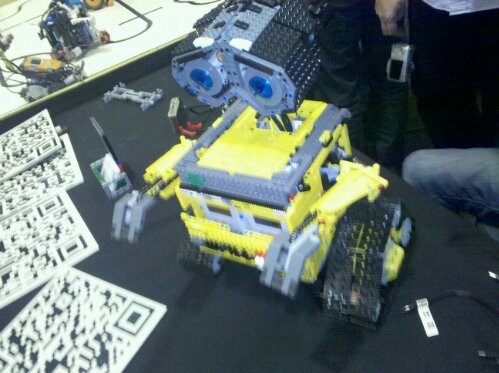- Lego Mindstorms Robotics Invention System 2.0 – Specification http://bit.ly/hxHUr7 /via @TransBotica #
- The Kinect Sensor in Mobile Robotics: Initial Experiments | Cheat … http://bit.ly/ijPkhG /via @TransBotica #
- Sprinting robot may soon be out running us all http://bit.ly/fDdn9U /via @club_robot #
- http://fb.me/NFpSCQ0X #
- Robotics team is recruiting new members http://bit.ly/hJwsj5 /via @zygbot #
- On BotJunkie.com: Aldebaran Robotics Taking Romeo Humanoid From Concept To Reality By March http://bit.ly/h71SRt #robotics /via @BotJunkie #
- The Tribotix Daily is out! http://bit.ly/h1PvUD ▸ Top stories today by @getroboticsjobs @robot_magazine @zoho @irobotspark /via @Tribotix #
- Video: Watch a Sprinting Robot Fall Down | Discoblog http://bit.ly/f0Qjny /via @club_robot #
Archiv des Autors: Sebastian Trella
Robodonien 2010
Bevor das Jahr um ist, hier noch ein paar Bilder, die dieses Jahr auf der „Robodonien 2010“ entstanden sind:
[nggallery id=1]
Twitter Weekly Updates for 2010-12-12
- I liked a YouTube video — 10 Minute dSolar Robot http://youtu.be/LXY2kJBeOcY?a /via @dexterind #
- On BotJunkie.com: Quadrotor + Kinect = One Weird Looking Robot http://bit.ly/gV30ws #robotics /via @BotJunkie #
- Programming Software – Products – VEX Robotics http://bit.ly/fd3JML /via @TransBotica #
- Arduino Uno + MakerShield + breadboard + more; $100 of microcontroller Products for $78! http://bit.ly/gefzBG #MAKEDotD /via @make #
- Autonomous quadrotor navigation with a Kinect – DIY Drones: http://bit.ly/hxOeP6 /via @robotants #
- Technical information on Kinect depth calibration: http://bit.ly/h4dmfR /via @willowgarage #
- Kinect on a Quadrotor: http://bit.ly/fo1XMg #ROS #PCL /via @willowgarage #
- Brief history of robotics. http://www.razorrobotics.com/history.html /via @RazorRobotics #
- New delivery of 800 Roberta adhesive foils for Lego Mindstorms NXT – just arrived! http://fb.me/OgmXkmWh /via @RobertaIAIS #
- http://www.facebook.com/photo.php?fbid=10150103019511117&set=a.239725471116.178864.200196311116&ref=nf http://fb.me/POKZMHln #
- New delivery of 800 Roberta adhesive foils for Lego Mindstorms NXT – just arrived! http://fb.me/OgmXkmWh /via @RobertaIAIS #
- great lego construction! http://fb.me/Q0v9a62H /via @RobertaIAIS #
- Service Robotics Innovation Summit at the INNOROBOEvent – March 2011, France: http://bit.ly/fqjQIY /via @RobertaIAIS #
BioBots an der Roberta-Academy – Deutsches Museum Bonn
08.12.2010 – Können Roboter fühlen? Was können Roboter von der Natur lernen? Die Beantwortung dieser und noch vieler weiterer interessanter Fragen gibt das Deutsche Museum in Bonn. Während eines viertägigen Ferienangebots an dem Kinder von 9 bis 12 Jahren, Robotern in Anlehnung an Vorbildern aus der Natur selbst konstruieren und programmieren können.
Das Ferienangebot findet in in Kooperation mit dem Zoologischen Forschungsmuseum Alexander Koenig statt.
Termine:
- 04. bis 07. Januar 2011
Am 13.8.2010 berichtete das WDR 5 Radio bei Klicker (Nachrichten für Kinder) über die ersten BioBots der Roberta-Academy des Deutschen Museums in Bonn. Zusätzlich werden die akustischen Eindrücke durch Fotos auf der Internetseite von WDR 5 Klicker ergänzt.
http://www.lilipuz.de/klicker/nachrichten-details/artikel/wie-die-tiere-mini-roboter/
Gemäß Konfuzius: Erkläre mir, und ich vergesse. Zeige mir, und ich erinnere. Lass es mich tun, und ich verstehe. wünscht Roberta allen Teilnehmerinnen und Teilnehmern 4 neugierige, spannende und interessante Tage!
Legoworld 2010 Zwolle #2
LegoWorld 2010 Zwolle
…currently packing, then starting towards the Netherlands….
/trella
Twitter Weekly Updates for 2010-10-17
- Mathe lernen mit MP3 – Lehrmodule des Fraunhofer SCAI mit Arbeitsblättern und mp3s http://bit.ly/d8LNBM /via @Fraunhofer #
- Google Announces Self Driving Robot Cars http://bit.ly/cwaWLH /via @TransBotica #
- Roberta is now official member of Fraunhofer Academy! http://fb.me/KCQ5TRvN /via @RobertaIAIS #
- Academic news | 10th IEEE-RAS International Conference on Humanoid Robots: http://www.humanoids2010.org/index.php /via @RobertaIAIS #
- "Google Car" by German Sebastian Thrun: http://www.nytimes.com/2010/10/10/science/10google.html?_r=1 /via @RobertaIAIS #
- Lego Mindstorm NXT enlisted for shirt-folding robot http://bit.ly/a4txoy /via @club_robot #
- Make: Online : Self-destructing robot contest http://bit.ly/b3vIXe /via @TransBotica #
- moverstreet is using the Personal Portable 3-D printer ($2690) to print his robot parts. http://pp3dp.com/ /via @robots_forever #
- Check out this robotic snake, called “Uncle Sam” from Carnegie Mellon that can actually climb trees! http://fb.me/z6phufRe /via @BNRobotics #
- Robot Programmed to Fall in Love with a Girl Goes too Far … http://bit.ly/bYqSkg /via @TransBotica #
- How cool is SnackBot?!? (part of the census at CMU) http://twitpic.com/2wrqfr /via @firstlegoleague #
- Google's robot cars http://bit.ly/abesFP /via @TransBotica #
- Google cars drive themselves, in traffic….http://nyti.ms/9v672E /via @firstlegoleague #
- Neuer Homepage-Artikel: STERN: DLR startet Raketenprogramm für Studenten: http://www.avgb.de/?p=000450 /via @AVGB_de #
- Lego's MINDroid Android app remotely controls Mindstorms NXT robots http://bit.ly/d0AQTu /via @club_robot #
- chumby-headed robot: going everywhere slowly http://bit.ly/bHXWJQ /via @club_robot #
- Don’t feel like going to the office today? Have a robot stand in for you! http://lat.ms/a1dvG3 http://fb.me/LsUjDfRe /via @BNRobotics #
- Why Japanese Love Robots (And Americans Fear Them) – MIT Technology Review (blog) http://bit.ly/aiUpGe /via @TransBotica #
- Microsoft Robotics Studio: On-Demand Videos and Screen-Casts: http://bit.ly/9EbIFJ /via @robotants #
- Do Androids Dream of LEGO MINDSTORMS? http://bit.ly/aQYw1W /via @robotsdotnet #
- Robots learning our pain threshold by punching humans and seeing … http://bit.ly/bHlASW /via @TransBotica #
- AquaTablet: the underwater robot http://bit.ly/aPiDzg /via @robots #
- iRobot Reveals iAdapt Technology for the Roomba and New Conceptual Robotic … – Chip Chick http://bit.ly/afQr5G /via @TransBotica #
- We're making 100 Cubelets kits to ship Jan 15. Preorders start in 90 minutes! http://www.modrobotics.com/cubelets /via @modrobotics #
- iRobot Sneak Peek: JamBots, LanDroids, and TransPhibians http://bit.ly/95WT5w /via @TransBotica #
- Power your NXT robot with solar panels http://t.co/GFFHVs1 via @make /via @dexterind #
Twitter Weekly Updates for 2010-10-10
- sFly: Swarm of Micro Flying Robots! [sFly]: http://bit.ly/aDcq16 /via @robotants #
- New Lightening Fast Hexapod Robot Kit In The Works (Video … http://bit.ly/agyS2T /via @TransBotica #
- ComBots Cup V, A Heavyweight Robot Combat Championship: http://bit.ly/a8oxnm /via @robotants #
- How to Build a Robot Tutorial – Society of Robots: http://bit.ly/97loUE /via @robotants #
- Lego PC Bot: http://bit.ly/bSAz9F /via @robotants #
- Fujitsu's social robot bear is the supertoy of Kubrick's dreams, almost (video) http://bit.ly/9ajKsX /via @club_robot #
- Fujitsu's Teddy Bear is a Social Robot http://bit.ly/dgYYO7 /via @TransBotica #
- Will Robots Someday Ask: "What is Life?" RT@dailygalaxy http://su.pr/1QKRW8 /via @MuseumofRobots #
- Cheap robotic hand http://bit.ly/as0uJW /via @club_robot #
- Personal robotics market forcasted to cross $19 billion in 2017 http://www.eeherald.com/section/news/nws20101062.html /via @AppliedRobotics #
Twitter Weekly Updates for 2010-10-03
- Huge Robot, little robot, little sheep.: Flats! posted a photo: This 5 meter tall robot stood overlooking the Spu… http://bit.ly/95KUQC #
- Robotic swarm over Switzerland http://bit.ly/bRELo9 /via @club_robot #
- Project Lab: http://bit.ly/cNSfG5 /via @robotants #
- The #RoboCup German Open will 2011 take place in Magdeburg from 31.3 to 3.4. /via @RobertaIAIS #
- Alicebot: http://bit.ly/8XCKBt /via @robotants #
- HEXBUGS® Swarm into the Holidays with New Micro Robotic Creatures and … http://bit.ly/ak3ID7 /via @TransBotica #
- nBot, a two wheel balancing robot: invert http://bit.ly/b1bM1w /via @robotants #
- "These are the droids you're looking for!" Android Humanoids … http://bit.ly/9rbOHW /via @TransBotica #
- I Have Seen the Furniture, and It Is Robotic | Science Not Fiction http://bit.ly/bl8maW /via @club_robot #
- Robot http://bit.ly/aNIlYf /via @TransBotica #
- IEEE Spectrum: A DIY Telepresence Robot http://bit.ly/aRpCDa /via @TransBotica #
- How to Build a Robot Tutorial – Society of Robots: http://bit.ly/bWVpqx /via @robotants #
- Underwater robot swims free thanks to newly-designed wireless controller (w/ Video) http://bit.ly/bOWNAN /via @club_robot #
- We won 3rd place of 20 at SICK Robot Day 2010! #srd10 #robocup #robotics /via @DarmstadtRescue Gratulation! #
Twitter Weekly Updates for 2010-09-26
- Scalable object recognition: http://www.willowgarage.com/blog/2010/09/20/scalable-object-recognition /via @willowgarage #
- robot gear tutorial: http://bit.ly/aJufxX /via @robotants #
- New "#Volksbot Lab" web page is now online: http://www.volksbot-lab.de /via @RobertaIAIS #
- Für euch entdeckt: Roboterhände packen vollautomatisch zu http://bit.ly/cYNNxz /via @KUKA_RoboticsDE #
- This robot called Core is primarily just a pair of bendable legs designed to carry weight up to 210 pounds http://bit.ly/bn5XQf /via @robots #
- Robotsblog schreibt von einem Android Handy 🙂 #
- windro robot: this roomba does windows http://bit.ly/dzXuey /via @club_robot #
- Automation becomes easy – KUKA Roboter GmbH at K 2010 http://bit.ly/a8XCqo /via @KUKA_RoboticsEN #
- Deadline for 25% early bird discount for #KUKA #youBot extended to September 30, 2010! http://youbot-store.com/ /via @KUKAyouBot #
- Tachometer: nerdbots posted a photo: http://bit.ly/csRE9u /via @robotants #
- Rosetta-Lander goes LEGO – a spacecraft model built out of Lego http://bit.ly/cHRlBG #Rosetta #Philae #Lego /via @DLR_de #
- You may also find the #Rosetta model videos here http://bit.ly/dwYAeZ /via @DLR_de #
- Pretty new web site: http://www.modrobotics.com /via @modrobotics #
- In 15 Minuten beginnt der Live-Stream vom Conrad Akkurace! Lasst euch dieses lustige Spektakel nicht entgehen unter: http://fb.me/Iz0hnfON #
- H2K2 Robot by Joseph Senior 10 http://bit.ly/a0Imgh /via @club_robot #
- Panhandling Robot http://bit.ly/b7g58b /via @TransBotica #

